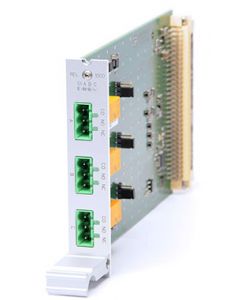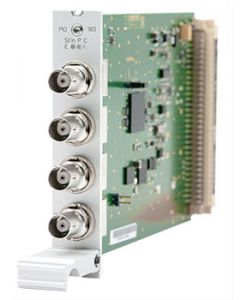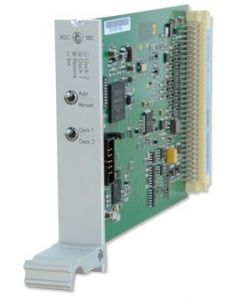
IMS-GNS Clock
IMS-GNS Clock
Meinberg
IMS Clock Module with Multi GNSS Receiver for GPS, Galileo, GLONASS and Beidou
Central clock module for the Meinberg IMS platform. The Multi GNSS receiver can use an external antenna to receive GPS, Galileo, GLONASS and Beidou satellite signals, decode them and use them as a reference source for the integrated, oscillator-based hardware clock. In addition to synchronizing with the GNSS systems, the IMS-GNS clock module accepts a wide range on input references when combined with IMS input cards.
Contact us for Lead Time
Click below to request a quote for this item. Or for product advice, stock and lead time enquiries call our team on 0330 313 3220.
| Attribute | Value |
|---|---|
| Manual URL | https://www.meinbergglobal.com/download/docs/manuals/english/ims-gns-receiver.pdf |
| Relative Humidity | Max. 85% |
| Further information |
The IMS-GNS module can be installed in any Clock (CLK) slot of your IMS system. It is capable of using all the various IMS reference sources, either by adding an MRI or ESI compatible input card or by using a network interface to Synchronise to an external NTP server or PTP/SyncE source. The Meinberg MRS concept supports setting up a prioritized list of input sources that are used to Synchronise the internal hardware clock of the IMS-GNS and then generate a large number of different output signals used by IMS I/O compatible cards to provide a user-defined selection of Synchronisation output signals by adding BPE, CPE or other IMS modules.
By combining the IMS-GNS module with another Clock module and an RSC switch card, a fully redundant Synchronisation solution can be created. The integrated GNSS receiver requires an external antenna. It can be configured to use GPS, Galileo, Beidou and GLONASS. The configuration supports to select one of these to be used exclusively or a combination of up to three of the sources. The receiver is capable of operating during high speed movement and delivers reliable and highly precise Synchronisation solutions in stationary installations and on fast moving vehicles, such as aircraft, ships or trucks. The signals generated by the CLK module can be used by adding one or more IO output cards like the BPE or CPE modules. Various output modules offer all kinds of different electrical or optical interfaces and signal types. The IMS-GNS module is hot-swappable and is automatically detected by the management CPU of an IMS system. |
| Interface | Single serial RS-232 interface |
| Status info |
Status info by 4 LED light indicators (2mm light pipes)
|
| Frequency Outputs | Accuracy depends on oscillator (standard: OCXO-SQ), see oscillator list |
| Pulse outputs | Pulse per second (PPS) and pulse per minute (PPM). TTL level, pulse width: 200msec |
| Accuracy of Pulse Outputs |
Depends on oscillator option: < ±100ns (TCXO, OCXO LQ) < ±50ns (OCXO SQ, OCXO MQ, OCXO HQ, OCXO DHQ, Rubidium) |
| Data format of interfaces |
Baud rate: 300, 600, 1200, 2400, 4800, 9600, 19200 Baud
Data format: 7E1, 7E2, 7N2, 7O1, 7O2, 8E1, 8N1, 8N2, 8O1 Time telegram: Meinberg Standard-Telegram , SAT, Uni Erlangen (NTP), SPA, Sysplex, RACAL, NMEA0183 (RMC,GGA,ZDA), Meinberg GPS, COMPUTIME, ION oder Capture-Telegramm |
| Generated Time Codes |
IRIG B002: 100pps, DCLS signal, no carrier, BCD time of year
IRIG B122: 100pps, AM sine wave signal, 1 kHz carrier, BCD time of year IRIG B003: 100pps, DCLS signal, no carrier, BCD time of year, SBS time of day IRIG B123: 100pps, AM sine wave signal, 1kHz carrier, BCD time of year, SBS time of day IRIG B006: 100 pps, DCLS Signal, no carrier, BCD time-of-year, Year IRIG B126: 100 pps, AM sine wave signal, 1 kHz carrier frequency, BCD time-of-year, Year IRIG B007: 100 pps, DCLS Signal, no carrier, BCD time-of-year, Year, SBS time-of-day IRIG B127: 100 pps, AM sine wave signal, 1 kHz carrier frequency, BCD time-of-year, Year, SBS time-of-day IEEE1344: Code according to IEEE1344-1995, 100pps, AM sine wave signal, 1kHz carrier, BCD time of year, SBS time of day, IEEE1344 expansion for date, time zone, daylight saving and leap second in Control Functions Segment C37.118: Like IEEE1344 - with turned sign bit for UTC-Offset AFNOR: Code according to NFS-87500, 100pps, AM sine wave signal, 1kHz carrier, BCD time of year, complete date, SBS time of day |
| Power supply - Maximum Power Range | +5V DC |
| Electrical Connectors | 96-pin VG-rail DIN 41612 |
| WEEE status of the product | This product is handled as a B2B category product. In order to secure a WEEE compliant waste disposal it has to be returned to the manufacturer. Any transportation expenses for returning this product (at its end of life) have to be incurred by the end user, whereas Meinberg will bear the costs for the waste disposal itself. |
| Type of Antenna |
40 dB Multi GNSS L1
Antenna with Integrated Lightning Protection for GPS, Galileo, GLONASS and Beidou signals Frequency Band: 1575.42 ± 10 MHz / 1602-1615 MHz Antenna Gain: ≥ 3.5 dBic / ≥ 3 dBic Nominal Impedance: 50 ohms Datasheet Multi GNSS Antenna |
| Cable type |
Coaxial cable Belden H155 indoor or outdoor usage
Maximum length of antenna cable: 70 meters |
| Synchronisation Time |
Max. 1 minute in normal operation mode, approx.
12 minutes after a cold start (discharged buffer battery) |
| Switch Outputs |
Four TTL outputs can configured independently for the following modes:
- free programmable cyclic or fixed impulses - timecode - timer mode; three 'ON'- and three 'OFF'-states can be setup per day The switch states can be inverted for all three outputs, the impulse lengths are configurable. The impulse output can be configured for all channels together to 'always' or 'ifsync'. |
| Backup Battery Type |
CR2032 - button cell lithium battery
When main power supply fails, hardware clock runs free on quartz basis, almanac data is stored in RAM Life time of lithium battery min. 10 years |
| Current Consumption | +5 V 1,1 A to 1,4 A (depends on oscillator option) |
| Receiver |
72 channel GPS / Galileo / GLONASS / Beidou receiver
Frequency band: L1 / E1 / B1 Antenna connector: SMA |
| RoHS | Yes |
| Key Features |
|
| Operating Temperature | 0 ... 50°C / 32 ... 122°F |
| Attribute | Value |
|---|---|
| Data Sheet | Click here to view |






